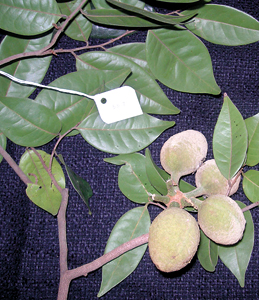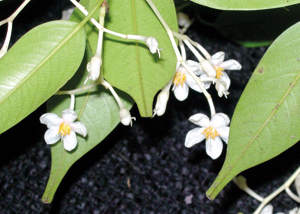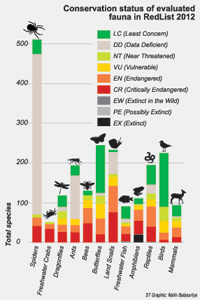News
Gone forever
View(s):Sri Lanka has permanently lost 19 amphibian species and five flowering plants. Malaka Rodrigo reviews the National Red List 2012
Here is sad news for those of us who care for the country’s endemic natural wealth. In fact, the news should sadden everyone, not just animal and plant lovers and conservationists.

Alphonsea hortensis fruit
It appears that we have permanently lost 19 amphibian species, all native to Sri Lanka, according to the National Red List of Conservation Status of Flora and Fauna of Sri Lanka 2012. The list, announced last week, notes that apart from the 19 amphibians that have gone extinct, two fish species, one reptile species and yet another amphibian species are labelled “possibly extinct at the national level.”
Plant lovers will mourn the permanent loss of five flowering plants, and fear for the 177 plants listed as “possibly extinct”
The grim news continues: One in every seven species of inland indigenous vertebrates, one in every two species of freshwater fish, amphibians, reptiles and mammals, and one in every five species of birds, are in danger of becoming extinct in the wild.
The Red List categorises threatened species in countries around the world. The list was created by the International Union of Conservation of Nature (IUCN). Threat levels fall into three categories: Critically Endangered, Endangered, and Vulnerable. When no living trace can be found of a species, it is categorised as “extinct.”
The “extinct” 19 endemic amphibians have not been seen or found in the past 100 years. Seventy-two of the 177 plants listed as “possibly extinct” are unique to Sri Lanka. If listed as extinct at the national level, then these plants are lost to the Earth forever.
The Red List evaluated a total of 2,264 faunal (animal) species, including 936 endemics, and 3,492 floral (plant) species, including seed-producing plants (gymnosperms) and ferns; 943 species are endemic.
Scientific data on many animal groups is lacking, and this is a big drawback in evaluating their conservation status, Sri Lanka Red List fauna coordinator Professor Devaka Weerakoon told the Sunday Times. Data deficiency is especially marked in the case of invertebrates and lower-level plants. For example, data is sparse on 404 out of 511 spider species, and 109 out of 194 ant species. “There’s an urgent need for research on the lesser studied groups,” Prof. Weerakoon said. “Some species could become extinct even before they are discovered. One in every five bird species, and one in every seven inland indigenous vertebrate species, is at high risk.”

Doona ovalifolia
Others on the threatened list are land snails (166), bees, butterflies, spiders, dragonflies, ants and freshwater crabs.
Freshwater crabs are at “extremely high risk.” This covers 90 per cent of the island’s total crab species. One in every two species of Sri Lankan freshwater crab is in imminent danger of extinction in the wild.
The last National Red List appeared in 2007. It was compiled by IUCN Sri Lanka and evaluate by to the Biodiversity Secretariat. Hundreds of experts contributed to the 2012 Red List, which will be used as a template for conservation action.
Some “extinct” plants, such as the Alphonsea hortensis and Doona ovalifolia, are found only in the Kandy Botanical Gardens.
National Red List flora coordinator Dr. Siril Wijesundara told the Sunday Times that more than 3,000 plants were evaluated for the 2012 list, 1,000 more than in 2007.
 |
 |
Follow @timesonlinelk
comments powered by Disqus

















